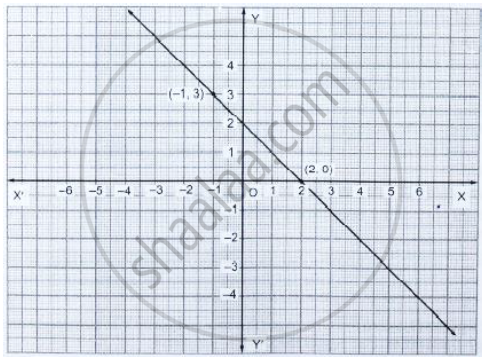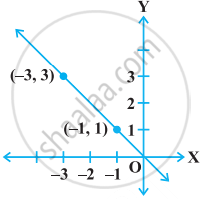Advertisements
Advertisements
Question
From the choices given below, choose the equation whose graph is given in fig. below.
(i) y = x + 2 (ii) y = x – 2 (iii) y = −x + 2 (iv) x + 2y = 6

[Hint: Clearly, (2, 0) and (−1, 3) satisfy the equation y = −x + 2]
Solution
Clearly ( 2, 0 ) and (-1 , 3 ) satisfy the equation y = -x + 2
∴ The equation whose graph is given by y = - x + 2
APPEARS IN
RELATED QUESTIONS
Draw the graph for the equation, given below :
y = 7
A straight line passes through the points (2, 4) and (5, - 2). Taking 1 cm = 1 unit; mark these points on a graph paper and draw the straight line through these points. If points (m, - 4) and (3, n) lie on the line drawn; find the values of m and n.
By drawing a graph for each of the equations 3x + y + 5 = 0; 3y - x = 5 and 2x + 5y = 1 on the same graph paper; show that the lines given by these equations are concurrent (i.e. they pass through the same point). Take 2 cm = 1 unit on both the axes.
Using a scale of 1 cm to 1 unit for both the axes, draw the graphs of the following equations: 6y = 5x + 10, y = 5x - 15.
From the graph find :
(i) the coordinates of the point where the two lines intersect;
(ii) the area of the triangle between the lines and the x-axis.
Draw the graphs of the following linear equations:
x = 3
Draw the graph for the following
y = 4x – 1
Find the values.
y = 3x + 1
| x | − 1 | 0 | 1 | 2 |
| y |
The graph given below represents the linear equation x + y = 0.

Determine the point on the graph of the linear equation 2x + 5y = 19, whose ordinate is `1 1/2` times its abscissa.
Write the linear equation such that each point on its graph has an ordinate 3 times its abscissa.
